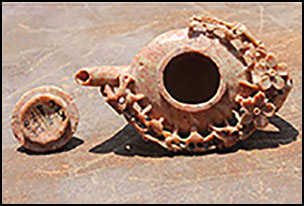Crossref Citations
This article has been cited by the following publications. This list is generated based on data provided by
Crossref.
Nyamushosho, Robert T.
Chirikure, Shadreck
Bandama, Foreman
Manyanga, Munyaradzi
and
Mukwende, Tawanda
2018.
Are drylands marginal? The case of Mananzve, Shashi region, southwestern Zimbabwe.
Azania: Archaeological Research in Africa,
Vol. 53,
Issue. 4,
p.
439.
Witcher, Robert
2019.
Editorial.
Antiquity,
Vol. 93,
Issue. 369,
p.
563.
Chirikure, Shadreck
2020.
Shades of Urbanism(s) and Urbanity in Pre-Colonial Africa: Towards Afro-Centred Interventions.
Journal of Urban Archaeology,
Vol. 1,
Issue. ,
p.
49.
Smith, Michael E.
2020.
Definitions and Comparisons in Urban Archaeology.
Journal of Urban Archaeology,
Vol. 1,
Issue. ,
p.
15.
Sulas, Federica
and
Pikirayi, Innocent
2020.
From Centre-Periphery Models to Textured Urban Landscapes: Comparative Perspectives from Sub-Saharan Africa.
Journal of Urban Archaeology,
Vol. 1,
Issue. ,
p.
67.
Chirikure, Shadreck
2020.
New Perspectives on the Political Economy of Great Zimbabwe.
Journal of Archaeological Research,
Vol. 28,
Issue. 2,
p.
139.
MacDonald, Kevin
Mitchell, Peter
and
Robertshaw, Peter
2020.
Editorial.
Azania: Archaeological Research in Africa,
Vol. 55,
Issue. 1,
p.
1.
Nyamushosho, Robert T.
Chipangura, Njabulo
Pasipanodya, Takudzwa B.
Bandama, Foreman
Chirikure, Shadreck
and
Manyanga, Munyaradzi
2021.
Nyanga pottery and the Manyika ethnohistory: towards a decolonised archaeology of the Nyanga agricultural complex.
Heliyon,
Vol. 7,
Issue. 3,
p.
e06609.
Leadbetter, Michael Paul
2021.
The fluid city, urbanism as process.
World Archaeology,
Vol. 53,
Issue. 1,
p.
137.
House, Michelle
Sealy, Judith
Chirikure, Shadreck
and
le Roux, Petrus
2021.
Investigating Cattle Procurement at Great Zimbabwe Using 87Sr/86Sr.
Journal of African Archaeology,
Vol. 19,
Issue. 2,
p.
146.
Goldstein, S. T.
Crowther, A.
Henry, E. R.
Janzen, A.
Katongo, M.
Brown, S.
Farr, J.
Le Moyne, C.
Picin, A.
Richter, K. K.
and
Boivin, N.
2021.
Revisiting Kalundu Mound, Zambia: Implications for the Timing of Social and Subsistence Transitions in Iron Age Southern Africa.
African Archaeological Review,
Vol. 38,
Issue. 4,
p.
625.
Moore, Tom
and
Fernández-Götz, Manuel
2022.
Bringing the Country to Town: ‘Rurban’ Landscapes in Iron Age Europe.
Journal of Urban Archaeology,
Vol. 5,
Issue. ,
p.
101.
Schoenbrun, David
2022.
Vashambadzi.
Radical History Review,
Vol. 2022,
Issue. 144,
p.
173.
Moffett, Abigail Joy
Nyamushosho, Robert. Tendai
Bandama, Foreman
and
Chirikure, Shadreck
2022.
Stringing Together Cowrie Shells in the African Archaeological Record with Special Reference to Southern Africa.
Journal of Archaeological Method and Theory,
Vol. 29,
Issue. 3,
p.
862.
Pikirayi, Innocent
Sulas, Federica
Nxumalo, Bongumenzi
Sagiya, Munyaradzi Elton
Stott, David
Kristiansen, Søren M.
Chirikure, Shadreck
and
Musindo, Tendai
2022.
Climate-smart harvesting and storing of water: The legacy of dhaka pits at Great Zimbabwe.
Anthropocene,
Vol. 40,
Issue. ,
p.
100357.
Nyamushosho, Robert T.
Chirikure, Shadreck
Sitas, Ari
and
Maṱhoho, Eric N.
2022.
Modelling Land Use in The Gold Belt Territories of Iron Age Southern Zambezia.
Land,
Vol. 11,
Issue. 9,
p.
1425.
Vieri, Jasmine
Chirikure, Shadreck
Lane, Paul
and
Martinón-Torres, Marcos
2023.
Archaeological science, globalisation, and local agency: gold in Great Zimbabwe.
Archaeological and Anthropological Sciences,
Vol. 15,
Issue. 8,
Bogaard, Amy
Ortman, Scott
Birch, Jennifer
Cervantes Quequezana, Gabriela
Chirikure, Shadreck
Crema, Enrico R.
Cruz, Pablo
Feinman, Gary
Fochesato, Mattia
Green, Adam S.
Gronenborn, Detlef
Hamerow, Helena
Jin, Guiyun
Kerig, Tim
Lawrence, Dan
McCoy, Mark D.
Munson, Jessica
Roscoe, Paul
Rosenstock, Eva
Thompson, Amy
Petrie, Cameron A.
and
Kohler, Timothy A.
2024.
The Global Dynamics of Inequality (GINI) project: analysing archaeological housing data.
Antiquity,
Vol. 98,
Issue. 397,
Thondhlana, Thomas Panganayi
2024.
Encyclopedia of Archaeology (Second Edition).
p.
132.
Maunganidze, Langtone
2024.
Representation and Materialization of Architecture and Space in Zimbabwe.
p.
45.



